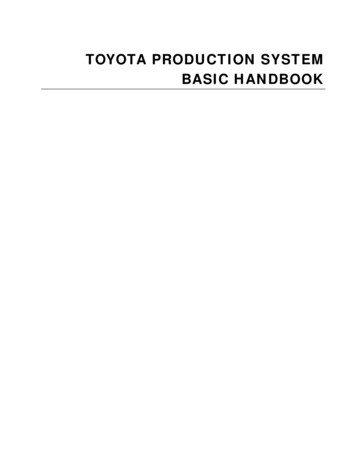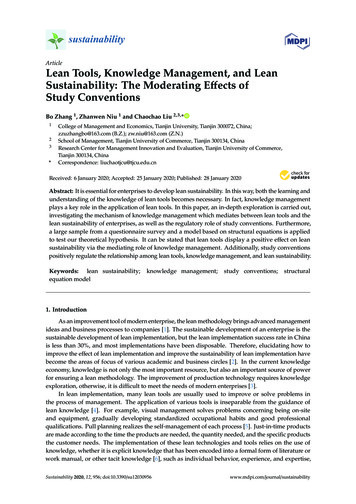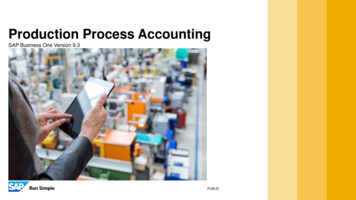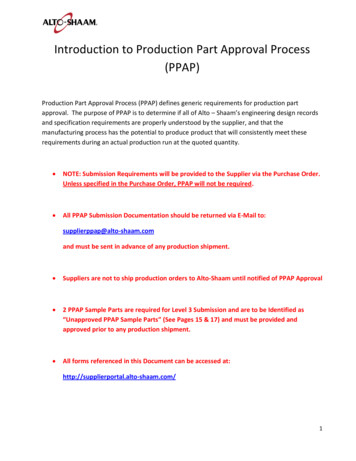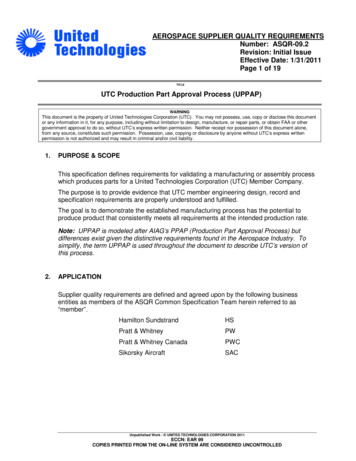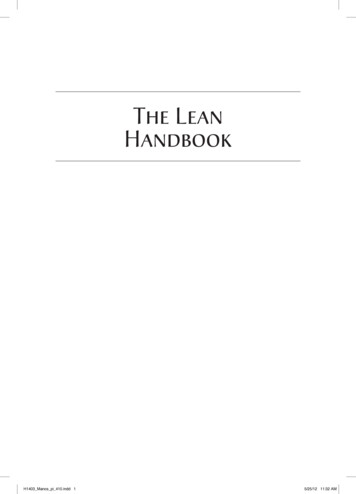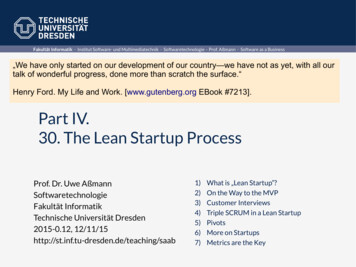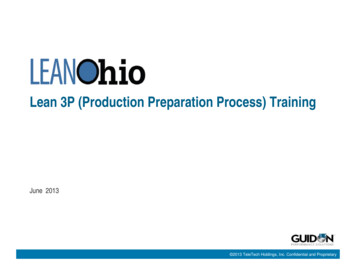
Transcription
Lean 3P (Production Preparation Process) TrainingJune 2013 2013 TeleTech Holdings, Inc. Confidential and Proprietary
Ground RulesThis is a learning environment, make the most of it Ask questions at any time Keep an open mind to change Respect each others views Never leave in a silent disagreement If you disagree with something/someone – say so, but prepare to bechallenged Practice mutual respect every day Treat others as you want to be treated One person, one voice—no position or rank There’s no such thing as a dumb question Be prepared to work! Understand the process and Just Do It!2 2013 TeleTech Holdings, Inc. Confidential and Proprietary
Week’s AgendaDay 1 3P / Design TrainingEvaluate VOCPrioritize CustomerrequirementsDay 4 Develop Projectplans Resource Planning CommunicationPlan for customers3Day 2 Define impact ofRequirements BrainstormAlternativesDay 3 Evaluate designalternatives Gap Analysis Develop KPI’s Business Plan Draft 2013 TeleTech Holdings, Inc. Confidential and Proprietary
Lean 3P (Production Preparation Process) Training3P IntroductionJune 2013 2013 TeleTech Holdings, Inc. Confidential and Proprietary
What is 3P?Lean 3P (Production Preparation Process) is an event driven process fordeveloping a new product / service concurrently with the operation that willproduce it and by the people that will interact with itResults in better products that require less initial capital and lowers ongoingunit costsUses Lean Six Sigma principles as part of the design – focused on customer3P enables the development of great productsThe right featuresThe right priceThe right costThe highest user Satisfaction5 2013 TeleTech Holdings, Inc. Confidential and Proprietary
3P allows for more reliable innovation Lean 3P 6Improve performance of newand existing products andprocessesDesign products and processesright the first timeDevelop alternatives to meetcore customer needsDone right first timeTraditional Innovation Over the wallLate to marketRework pre-launch and post launchHigh Developmental costsNo optimized for Lean 2013 TeleTech Holdings, Inc. Confidential and Proprietary
Why Does 3P work 7Intense cross functional collaborationProduct Development concurrently with ProcessRapid Learning and Try-StormingProcess that moves quickly through a series of stepsActivate our thinking and help us gain understandingEvaluate and converge upon optimum solutions 2013 TeleTech Holdings, Inc. Confidential and Proprietary
When to use 3P?New ProductNew ClientRecovery / TurnAround8Design ChangesChange incapacityChange inDemand 2013 TeleTech Holdings, Inc. Confidential and Proprietary
3P Key ComponentsVOC – Planning &PreparationVOC – InterpretCustomer RequirementsConceptual DesignDetailed DesignPilot and Full ScaleImplementation9 Customer – Market research plan CTXs : CTQs, BusinessRequirements (BR) 1-3 Alternatives – “At a Glance” Process/Product Design Detailed Pilot layout, Ramp up plan 2013 TeleTech Holdings, Inc. Confidential and Proprietary
Sigma Kaizen Methodology3P CycleNew product /serviceProduct/ServiceInnovationVOC – Planning &PreparationPilot and Full ScaleImplementationDetailed Design3PCycleVOC – InterpretCustomer RequirementsConceptual DesignProcessInnovationReengineeringRFI or RFP10 2013 TeleTech Holdings, Inc. Confidential and Proprietary
3P Session OverviewVOC – Planning &Preparation daysResearch data plan, Targetedcustomers, Customer segmentation,Benchmarking plan,Research data, Benchmarkdata, Competitive analysisVOC – InterpretCustomerRequirementsCTQ/P’s, SLA’s, Preliminaryspecifications, House of Quality,Weighted CTQ elements, Businessrequirements, Competitive analysisplanConceptual DesignHi-level process steps/map,Relationship of process steps to CTQ,1 to 3 best alternative designs, Hi-levellayout, Targeted technology &equipmentSkunk works, 1-3 bestalternatives, Leanconcepts,“Process/Product Glance”Detailed DesignDetailed process, Layout, Staffing, QualityChecks, Standard Ops, High levelimplementation plan, Final technology &equipment, Metrics, supplies/materials, Pilotplan, FMEA, Control plan, Training docsOutputs from DetailedDesignPilot and Full ScaleImplementationValidated design/process, Detailedimplementation plan, Sign offs &approvals, Revised: Standard Ops,Staffing plan, Control plan, FMEACTQ’s, SLA’s,Specifications, HOQ, LeanDesign Principles,11Concept – Features & SLA’sCustomers, Proposal,Product/service concept,Preliminary CTQ’sConceptual DesignOutputsDetailed DesignSessionProject Time lineInputs 2013 TeleTech Holdings, Inc. Confidential and Proprietary
Lean 3P (Production Preparation Process) Training3P - VOC – Planning & PreparationJune 201312 2013 TeleTech Holdings, Inc. Confidential and Proprietary
Identifying CustomersWho Are Our Customers?What Do They Need?What Do They Want?Are All Customers The Same?How do we find out?13 2013 TeleTech Holdings, Inc. Confidential and Proprietary
Identifying CustomersReview Engagement ProposalWhose needs must be net for this product/process to be successful?Are all customers equally important?Are there other potential key customers (either external or internal)?14 2013 TeleTech Holdings, Inc. Confidential and Proprietary
Identifying CustomersHigh-Level Process ustomersMeasuresMeasuresProcessMap151 - 15 2013 TeleTech Holdings, Inc. Confidential and Proprietary
Gather Customer NeedsPassiveActiveInterviewLearn About A Specific Customer’s Needs And Requirements,Customer Values And Point-Of-ViewOn Service Issues, Product/Service Attributes, And PerformanceIndicators/Measures; Supports Development Of Hypotheses AboutCustomer ValuesFocus GroupOrganize Information From The Collective Point Of View Of A GroupOf Customers That Represent A Segment; Helps Define A SegmentAnd Prioritize Customer ValuesSurveyMeasure The Needs And Customer Values For – Or The ImportanceAnd Performance Of – A Product, Service Or Attribute Across AnEntire Segment Or Group Of Segments; Furnishes “Hard” EvidenceTo Support Decision-MakingInternal Research& Listening PostsSearch For Customer Needs And Requirements, Product/ServiceAttributes, Customer Values,And Performance Indicators/Measures From Secondary SourcesSelect customer research method(s)161 - 16 2013 TeleTech Holdings, Inc. Confidential and Proprietary
What Questions Do We Ask Our Customers?Kano Model:CustomerSatisfactionHighExcitementFully ImplementedProductFunction AbsentThresholdLowWhich characteristics drive customer satisfaction?171 - 17 2013 TeleTech Holdings, Inc. Confidential and Proprietary
Drivers of Customer SatisfactionThreshold Attributes:Expected attributes – “musts” of a productIncreasing performance of these attributes provides diminishing returnsAbsence (or poor performance) of these attributes results in extremecustomer dissatisfactionExample – brakes on a car18 2013 TeleTech Holdings, Inc. Confidential and Proprietary
Drivers of Customer SatisfactionPerformance Attributes:More is generally better – customers will typically pay more for theseattributesIncreasing performance of these attributes improves customer satisfactionAbsence (or poor performance) of these attributes results in lowercustomer satisfactionThese attributes form weighted needs upon which product concepts willbe evaluatedExample – fuel economy in a car19 2013 TeleTech Holdings, Inc. Confidential and Proprietary
Drivers of Customer SatisfactionExcitement Attributes:Unspoken and unexpected by customersIncreasing performance of these attributes results in high levels ofcustomer satisfactionAbsence (or poor performance) of these attributes does not result in lowercustomer satisfactionIdentifying and providing these attributes provides a competitiveadvantage (until they morph into Performance Attributes)Example – rear video camera in a car for backing up20 2013 TeleTech Holdings, Inc. Confidential and Proprietary
Segment CustomersDefine Customer SegmentsSegmentation is recommended to focus customer research on themost important customers: First, determine logical customer segments(Region, Type Of Business, Size, etc.) Then, write a definition of each customer segment21 2013 TeleTech Holdings, Inc. Confidential and Proprietary
Prioritize Customers / SegmentsWho are the critical customers/customer groups forthe product or service?All customers/segments are not of equal importanceIdentify the “Vital Few” and “Useful Many” customersExample: Personal computer leasing service Vital Few: Large companies who lease 500computers for long-term ( 1 Year) Useful Many: Small companies who lease 1-10computers for 6 months-1year22 2013 TeleTech Holdings, Inc. Confidential and Proprietary
Lean 3P (Production Preparation Process) Training3P - VOC – Interpret Customer RequirementsJune 2013 2013 TeleTech Holdings, Inc. Confidential and Proprietary
Understand Customer RequirementsUtilize the voice of thecustomer as an input toproduct expectations.241 - 24 2013 TeleTech Holdings, Inc. Confidential and Proprietary
Identifying CustomersWho are our customers?What do they need?What do they want?Are all customers the same?How do we find out?25 2013 TeleTech Holdings, Inc. Confidential and Proprietary
Are you connected to your Customers?26 2013 TeleTech Holdings, Inc. Confidential and Proprietary
Lean Six Sigma Starts with the CustomerCustomer focus begins by linking business strategyand customer wants and needsThere are two major types of customers, with differingneeds Internal Customers (partners) External CustomersCustomers wants and needs can be determined inmany ways Surveys Interviews Focus groups, etc27 2013 TeleTech Holdings, Inc. Confidential and Proprietary
Voice of the Customer ContextOrganizationalObjectives& GoalsVoice ofBusiness(VOB)ClientExpectationsVoice ofProcess(VOP)Voice ofCustomer(VOC)ImprovementProjects28 2013 TeleTech Holdings, Inc. Confidential and Proprietary
If the customer requirements are not explicit,clarify and quantify themVoiceof theCustomer(VOC)Voiceof theCustomerthemeCritical toQuality(CTQ)CharacteristicThe support for thissystem is lousy!Nobody is dealing withthe problems wereportThe new release ofproduct is full ofproblemsCustomer needsProduct problems tobe dealt withpromptlySupport staff willrespond within 30minutes of a problembeing reportedCustomer needsproduct to bedelivered error freeProduct will bedelivered right firsttimeCustomer needs aquicker turnaroundtime on ordersCustomer orders willbe approved internallywithin 1 day of theinitial requestThe procurementprocess takes too long.We may not get thehardware in time29 2013 TeleTech Holdings, Inc. Confidential and Proprietary
Lean Six Sigma starts with the Customer Customer information istranslated to the business ascustomer requirements, orcritical to quality (CTQ)requirements Excelling at fulfilling customerCTQs can drive differentiation Differentiation can give acompetitive advantage inproducts and services304 - 30 2013 TeleTech Holdings, Inc. Confidential and Proprietary
What Satisfies the Customer?CustomerSatisfactionKano Model:HighDELIGHTERSBreakthrough CustomerSATISFIERSNeeds/FeaturesCore CompetitiveRequirementsExcitementFully ImplementedServiceElement AbsentThresholdDISSATISFIERSBasic RequirementsLowUnderstand which service elementsdrive customer satisfaction311 - 31 2013 TeleTech Holdings, Inc. Confidential and Proprietary
Kano AnalysisGenerate a list of customerrequirements (CTQs)Review the Kano AnalysisIdentify the appropriate categoryfor each requirement.HIGH CustomerSatisfactionDELIGHTERSWork through the list ofrequirements one by one. Markeach as to whether it is a:Dissatisfier – Basic RequirementDelighterSatisfier – More Is BetterDetermine prioritiesTurn high priorities intoobjectives and take forwardBreakthrough CustomerNeeds/FeaturesSATISFIERSCore CompetitiveRequirementsNotDoneOr DonePoorlyXDoneVeryWellDISSATISFIERSBasic RequirementsLOW CustomerSatisfaction324 - 32 2013 TeleTech Holdings, Inc. Confidential and Proprietary
Reactive and Proactive DataReactive data comes to you33Proactive data is gathered byreaching out to the customer 2013 TeleTech Holdings, Inc. Confidential and Proprietary
“Voice of the Customer” sample survey results34 2013 TeleTech Holdings, Inc. Confidential and Proprietary
Reactive DataReactive data reflects past performance, is oftenrelated to customer dissatisfaction and can bereflected through:Customer ComplaintsHelp Desk calls or emailsSales DataCredits due to contested paymentsWarranty claimsProduct returns35 2013 TeleTech Holdings, Inc. Confidential and Proprietary
Proactive DataProactive data requires more effort to collect, butcan provide more current and specific information.Examples include:InterviewsFocus groupsSurveysComment cardsSales callsCustomer visitsMarket researchCompetitive Analysis36 2013 TeleTech Holdings, Inc. Confidential and Proprietary
Surveys and Sampling Surveys are used to find out more about customers:–Opinions–Attitudes–Preferences Sampling is a method of gathering information aboutpopulations from a cross section of individualsWhat are some ways to survey andthe potential pitfalls of each?And for your project?37 2013 TeleTech Holdings, Inc. Confidential and Proprietary
VOC and Customer ExpectationsProcess Capability compares the Voice of the Customer (VOC) to theVoice of the Process (VOP) assessing a process to see if it meetscustomer requirements VOC specifications given by the Customer for the product VOP the distribution of the data obtained from the processLower SpecLimitVoice of the CustomerUpper SpecLimitXVoice of the Process38 2013 TeleTech Holdings, Inc. Confidential and Proprietary
Customers Experience Variation, not AveragesPilot APilot BEnd of runway!Avg. distanceto stopAvg. deviation from center of runwayWhich pilot would you want to fly with?39 2013 TeleTech Holdings, Inc. Confidential and Proprietary
Define CTQ’s (output measures)We measure improvements in process/serviceperformance by monitoring the process outputsYou should have identified the highest priority goals foryour project and now you need to create a measure forthemThis output measure is frequently called a CTQ –Critical to Quality characteristicCTQ’s are the high level process measures that will tellyou and the customer whether the improvements thatyou make have had an effect on the area the customerneeds40 2013 TeleTech Holdings, Inc. Confidential and Proprietary
CTQ TreesA Tool to Help Derive CTQsWhat does a Tree diagram do?Converts general customer goal statements intomore detailed Critical To Quality Characteristics(CTQs) From general “WHAT” to specific “HOW”Takes input from all the sources identified inprevious VOC activities i.e. KanoMaintains an iterative process until you end upwith things that are meaningful, measurable andactionable41 2013 TeleTech Holdings, Inc. Confidential and Proprietary
CTQ Trees – ExampleSystemAvail.Fast responsetimesMax response time 0.2 secsMinimaldowntimeSystem available Mon-Sat 07:00Flexible response toovertime requestsGoodServiceCalls answeredpromptlyGoodSupportTrouble ticketsactioned quicklySeverity Level 1 tickets 4 hrsPassword resets 2 hrsFiles sent to 3rdparties on time42 2013 TeleTech Holdings, Inc. Confidential and Proprietary
CTQ Tree – ExerciseSplit into groupsOne of you should act as the customer and express a general servicerequirement for the simulation exercise or your projectThe others should work with you to translate the general requirement into aseries of concise specifications using the CTQ Tree methodAim to record 2-3 detailed specifications43 2013 TeleTech Holdings, Inc. Confidential and Proprietary
Lean 3P (Production Preparation Process) Training3P - Conceptual DesignJune 2013 2013 TeleTech Holdings, Inc. Confidential and Proprietary
Develop AlternativesWhy Discover potential improvement Force new look at product/processWho Key stakeholders and SMEsWhen Dramatic change in product/process: volume, requirements,technology New product/process Relocation/consolidation or Recovery Respond to RFP45 2013 TeleTech Holdings, Inc. Confidential and Proprietary
Develop AlternativesWhat - Deliverables Multiple: Product visual, process map, layout, Quality plan,accessories, equipment plan, FTE plan, etc High level : “At a glance”How Managed Creativity exercises Structured Approach Brainstorming Documentation of ideas46 2013 TeleTech Holdings, Inc. Confidential and Proprietary
Steps to Develop AlternativesTime Base Strategy / Lean Concept and TrainingManaging creativity Rules of creativity Recognizing barriers to creativity Exercises in creativityReviewing current product / process What are the outputs What are the true customer and business requirements Identify Value AddBrainstormingMap alternativesDocument alternativesDeliverable: processes at a glance47 2013 TeleTech Holdings, Inc. Confidential and Proprietary
Design Principles 48Minimize wasted motions by the operators.Facilitate operator flexibility, not process order.Enable minimal staffing.Don’t disrupt operator flow with material flow.Each process must ensure quality before passing theproduct to the next process.Quality assurance methods must be consistent with theprocess.Place in coming items entrance & finished item exitpoints together.Consider an “open room” arrangement.Avoid isolated islands 2013 TeleTech Holdings, Inc. Confidential and Proprietary
Design Principles cont. 49Use highly-visible management to facilitate rapidresponse to abnormalitiesMinimize transport distancesMinimize workstation sizeEnsure that work is “belly high” and “forearm deep”Standard operationsSegregate complexityFlow processCommon tempoQuality at the sourceMinimize wasteFeedback – HPC Ecosystem 2013 TeleTech Holdings, Inc. Confidential and Proprietary
Design Principles cont. 50Ensure that work is “belly high” and “forearm deep”Standard operationsSegregate complexityStandard operationsFlow processCommon tempoLink processesQuality at the sourceMinimize wasteFeedback – HPC EcosystemEngineered loading 2013 TeleTech Holdings, Inc. Confidential and Proprietary
Managing CreativityAcknowledge need for “change”Review barriers to creativityReview rules of creativityExercises to stimulate new ideasBrainstorming51 2013 TeleTech Holdings, Inc. Confidential and Proprietary
Rules of Managed CreativityI will not judge another person’s ideaI will overcome hurdles in my own thinking andgenerate creative ideasI will make every effort to look at each situationand problem from many anglesI will express my ideas openly and not fear theopinion of othersI will return to my 12 year old mindset52 2013 TeleTech Holdings, Inc. Confidential and Proprietary
Rules of Managed CreativityBlank page (no preconceived ideas)Creativity before capitalMultifunctional team (stakeholders)Short time frame to conceptLots of ideasNo money53 2013 TeleTech Holdings, Inc. Confidential and Proprietary
Barriers to Creativity541. The right answer5. That’s not my area2. Follow the rules6. Don’t be foolish3. Be practical7. Avoid ambiguity4. Play is frivolous8. To err is wrong4 - 54 2013 TeleTech Holdings, Inc. Confidential and Proprietary
1. The Right AnswerQuote: “Nothing is more dangerous than an idea when it’s the only oneyou have.” French Philosopher Emile ChartierApproach: Look for the second right answer Get a lot of good ideas Change the questionTechniques: What if? Play the fool Reverse the problem Break the rules Ask for plural answers55 2013 TeleTech Holdings, Inc. Confidential and Proprietary
2. Follow the RulesQuote: “If you don’t ask “why this?” often enough, somebody will ask “why you?””Physicist Tom Hirshfield.Approach: Challenge the normal patterns Suspend all rules Start with a “white board”.Techniques: Rules exist for a reason determined at one time. That time has passed – shouldthe rules? Gather the rules, and then throw them all out. Examine one by one, only accept back rules that are still absolutely necessary. Find a Sacred Cow – slay and grill it56 2013 TeleTech Holdings, Inc. Confidential and Proprietary
3. Be PracticalQuote: “Every child is an artist. The problem is how to remain an artistafter growing up.” Pablo PicassoApproach: Ask “what if?“ questions. Imagine how others would do it. Use as stepping stones, extrapolate from ideasTechniques: Avoid “premature evaluations” Exercise the “creative no” Imagine you are the idea57 2013 TeleTech Holdings, Inc. Confidential and Proprietary
4. Play is frivolousQuote: “Play is what I do for a living. The work comes in organizing theresults of the play.” System ArchitectApproach: When do you normally get new ideas? Pause for a bit Use incubation One O’clock should mean something newTechnique: When you have a problem, play with it Pause, incubate, “play” Revisit If you don’t have a problem, play anyway58 2013 TeleTech Holdings, Inc. Confidential and Proprietary
5. That’s not my AreaQuote: “Make it a point to be on the lookout for novel and interesting ideas thatothers have used successfully in the past. Your idea has to be original only in itsadaptation to the problem you are currently working on.” Thomas EdisonApproach: Forget specialization Use cross fertilization Be an ExplorerTechnique: Steal shamelessly Change roles titles Look outside your discipline or industry59 2013 TeleTech Holdings, Inc. Confidential and Proprietary
6. Don’t be foolishQuote: “ We all know your idea is crazy. The question is, whether it is crazyenough.”Niels BohrApproach: Don’t just “go along” – avoid groupthink. Consult a fool – think like one Put on your fools capTechnique: Reverse assumptions Be irreverent Make jokes – laugh at it Reverse you viewpoint, do the opposite of what is expected60 2013 TeleTech Holdings, Inc. Confidential and Proprietary
7. Avoid AmbiguityQuote: “ The little I know I owe to my ignorance.” AnonymousApproach: Look for ambiguity – specificity destroys ideas Find paradoxes Let random information stimulate thoughtTechniques: How else can this be interpreted? Listen to your dreams. Ask an Oracle61 2013 TeleTech Holdings, Inc. Confidential and Proprietary
8. To err is wrongQuote: “If you are not failing every now and again, it is a sign you arenot trying anything very innovative.” Woody AllenApproach: Try something new Produce new ideas first, not right ideas See failure is a learning experience. Use it to produce something newTechnique: Use an error to stimulate thinking – stepping stone to new idea Ask what bad things can happen if I do this?62 2013 TeleTech Holdings, Inc. Confidential and Proprietary
Managed Creativity: SummaryGive yourself a license to be creativeBecome an:Explorer – search for new information and resourcesArtist – new resources and information into new ideasJudge – evaluate merits of ideas and what to do with itWarrior – convert ideas into action63 2013 TeleTech Holdings, Inc. Confidential and Proprietary
Creative Exercise1.Below is the Roman numeral seven. Add a single line to make it 8.VII2.Below is Roman numeral nine. Add a single line to make it 6.IX3.A king is to give his throne to one of 2 sons. He will have his sons competein a horse race in order to determine the successor of the throne. Whoeverowns the slower horse gets the throne. The sons – fearing each other willcheat by slowing down their horse – ask the court jester how to ensure a fairrace. The jester answers with 2 words.What are those 2 words?64 2013 TeleTech Holdings, Inc. Confidential and Proprietary
Review Process - ProductWhat are the customer requirements? (CTQs, CTP) List or review SIPOCWhat are the business requirements?How are requirements met?Map the current process at a high Level Physical flow Information/data flow Value add vs. non-Value AddReview barriers of Creativity Which Techniques can you apply to your product or process Try at 2-3 techniquesBrainstorm on Alternatives to deliver CTQs. CTPs, BRs65 2013 TeleTech Holdings, Inc. Confidential and Proprietary
Brainstorming1.2.3.4.5.6.7.8.Generate ideas: Structured or non-structureDocumentEveryone ParticipatesNo criticismExhaust ideasReview and ClarifyDiscard duplicateOrganize common themes Use affinity mapping if needed9. Common themes become basis for alternatives10. High level evaluation to judge alternatives See Appendix : Lean, Design Principles66 2013 TeleTech Holdings, Inc. Confidential and Proprietary
Document AlternativesHigh Level “sketch” or Design of AlternativesInclude key components of product / process 67Visual of productProcess flow : physical, informationReport layoutsInformation flowQuality assurance methodAccessoriesEquipmentTechnologyFTEsWork MethodsEtc. 2013 TeleTech Holdings, Inc. Confidential and Proprietary
Design PrinciplesJust-In-Time Is.A business system which produces: What the customer wants In the quantity the customer wants When the customer wants itWhile using minimum resources: 68PeopleSpaceMaterialsEquipment 2013 TeleTech Holdings, Inc. Confidential and Proprietary
Design Principles cont. .By Focusing and Eliminating Waste of: Defects Excess motion Over Production Over Processing Excess Material / Information / Inventory Transportation Waiting69 2013 TeleTech Holdings, Inc. Confidential and Proprietary
Pugh MatrixThere are a variety of methods for selecting a best designconcept from among alternatives. With a Pugh Matrix, conceptsare compared to a base case and the best features of conceptsare combined to develop a superior concept.The basic Pugh Selection process is as follows:1.2.3.4.Generate a number of design concepts.Develop evaluation criteria (10-20 at most, highest priority CTQs).Pick the best current concept as the baseline.Score each alternative as better ( ), same (S) or worse (-)against the baseline for all criteria.5. Attempt to combine superior features of different concepts.6. Continue until the “best” concepts appear.70 2013 TeleTech Holdings, Inc. Confidential and Proprietary
Pugh Matrix: Evaluate 7 AlternativesSum of PositivesSum of NegativesSum of SamesWeighted Sum of PositivesWeighted Sum of pt 7SS Concept 6SSS S-Concept 5SSSSSSSSSSConcept 4Concept 3New DesignKey CriteriaAbility to provide loan amountApplication timeKnowledgeable representativesAvailability of representativesInformation requirementsProcessing timeCost/TransactionDefects/TransactionDevelopment budgetFollows design principlesConcept 2New DesignConcept Selection LegendBetter SameSConcept 1Baseline DesignConcepts3251435335Analysis: Concept 3's negatives outweigh its positives and should be dropped from further consideration.Concept 2 has a slight edge over the others but is not a clear winner. More thought should go intorefining/improving this concept.711 - 71 2013 TeleTech Holdings, Inc. Confidential and Proprietary
Lean 3P (Production Preparation Process) Training3P - Detailed DesignJune 2013 2013 TeleTech Holdings, Inc. Confidential and Proprietary
Simulation StepsFor the best concepts:Create high-level process map (if not already completed)Determine the Critical To Process steps/variablesDetermine design elements for simulationSimulate the process Simulate equipment and operatorsUse workstation toolsUse actual material or make prototypesBuild the product & the production areasGet into the details of the processSimplify the process steps for the operatorObserve the processContinue to simulate & eliminate wasteCollect data as you goReview the alternative concepts and select best one73 2013 TeleTech Holdings, Inc. Confidential and Proprietary
Simulation StepsFor complex processes:Start with the critical process stepsBreak into teams to cover more ground74 2013 TeleTech Holdings, Inc. Confidential and Proprietary
Review: Pugh Matrix Analysis75Key CriteriaAbility to provide loan amountApplication timeKnowledgeable representativesAvailability of representativesInformation requirementsProcessing timeCost/TransactionDefects/TransactionDevelopment budgetFollows design principlesSSSSSSSSSSSSS S-SS Sum of PositivesSum of NegativesSum of SamesWeighted Sum of PositivesWeighted Sum of Negatives0010004241110271623Importance RankingConcept 7Concept 6Concept 5Concept 4New DesignConcept 3New DesignConceptsConcept 2Baseline DesignConcept Selection LegendBetter SameSWorse-Concept 1Best 3 Alternatives32514353351 - 75 2013 TeleTech Holdings, Inc. Confidential and Proprietary
High-Level Process MapCreate a process map complete with:Mail OpeningProcess stepsProcess step outputs – “Y”Process step inputs – “X”x1x2YesY1Nox3Y2NoWorkupYes761 - 76 2013 TeleTech Holdings, Inc. Confidential and Proprietary
Design ElementsThe Total Design Concept: ElementsDepending On The Product/Service (Or Function) To BeDesigned, The Following Design Concept Elements WillBe uct/ServiceLean uction”ProcessSpecific Design Methods for Different Disciplines (i.e. InformationTechnology) are Employed to Develop Concepts and Further Details771 - 77 2013 TeleTech Holdings, Inc. Confidential and Proprietary
Design Elements iveryFormsSafetyTransport Arrangement StorageEducation/TrainingAttitude & MoraleManagement StructureControl PlanHardwareLeadershipData FlowsTasks & JobsPerformance FeedbackCustomersSuppliesSoftwareMaterialsData ProcessRoles & ResponsibilityLeanSix SigmaServiceData NeedsEquipmentErgonomicsMoment Of TruthHumanSyste
Lean 3P (Production Preparation Process) is an event driven process for developing a new product / service concurrently with the operation that will produce it and by the people that will interact with it Results in better prod
